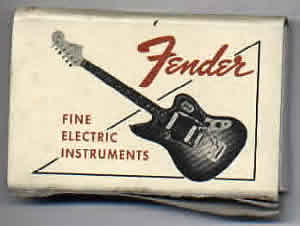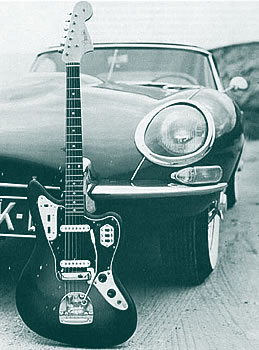The History
 This information on the history of the Jaguar and the Jazzmaster is collected from many sources – most from the www.
This information on the history of the Jaguar and the Jazzmaster is collected from many sources – most from the www.
Even though I did some research this may be wrong on some points. I took the specs 1958-1987 from the Vintage Guitars Info site and added some more info. I found the general information on Mel Waldorf’s Jaguar & Jazzmaster pages. If you have additional info or if you see something totally wrong, please contact me.
Jazzmaster – for Jazzmasters?
When Fender introduced the Jazzmaster in 1958, it was designed to replace the Stratocaster as the top model. It featured a new body shape – the “Offset Waist Contour Body”, that meant to provide a better balance and comfort. The Jazzmaster was an attempt to enter the jazz market, too, so it was equipped with newly designed pickups with a mellower sound than the Stratocaster or the Telecaster, rather like a hollow body guitar. Unlike the single coils of the Stratocaster, the single coils of the Jazzmaster are wide and rather flat, covered in a white rectangular housing. So they pick up a wider area of the vibrating strings and thus their sound is less “pointy”.
The Jazzmaster was the first of Fender’s guitars with a rosewood fretboard – which later was offered for the other models, too.
Leo Fender designed an all-new vibrato system (floating tremolo and bridge with individually adjustable barrels) and a new electronics circuit for the Jazzmaster: The circuit allows the player to preset two different tone- and volume settings and to change between the two settings simply by flipping one switch. One circuit controls only the neck pickup (the rhythm-circuit) and the other (the lead-circuit) has a three-way toggle switch that selects the two pickups alone or together. The guitar has brass-shielded cavities and a aluminium covered pickguard because the wide singlecoils are very sensitive towards hum and circuit-noise. Additionally, the two pickups are mirrored (coil winding and polarity) so when played together, a hum-cancelling effect is achieved.
Few jazz players were interested – despite the promising name and the design features – but soon the guitar was used by rock’n’roll- and surf guitarists…
More info on the changes on Jazzmaster models throughout the 60’s in this great article by Greg Gagliano.
Jazzmaster specs:
available colors (Nitro-Cellulose Lacquer Finish): 3-Color Sunburst, Candy Apple Red, Olympic White, Black, Sherwood Green, Dakota Red.
- 1958: Alder contour body, three color sunburst finish. Anodised aluminium pickguard with two wide pickups with white plastic covers. Serial number on neck plate. Slab rosewood fingerboard.
- Mid 1959: Celluloid tortoise three layer pickguard.
- Mid 1962: Veneer Rosewood fingerboard.
- Late 1964: Gold Fender “transition” decal thicker than previous “spaghetti” logo (late summer 1964). Pearl fingerboard dots replace “clay” dots. Plastic tortoise three layer pickguard replaces celluloid.
- Mid 1965: Volume/Tone knobs change from a Stratocaster style knob to a unique white with chrome top Jazzmaster knob (“Witch Hat Knob”).
- Late 1965: White binding on neck.
- Mid 1966: Rectangle position markers replace dots. “F” style tuning gears replace “Kluson-Deluxe” gears.
- Mid 1967: Peghead shape enlarged.
- 1967/68: Black Fender decal. Polyester thick finish replaces nitrocellulose lacquer. The faceplate of the necks remained lacquered in nitro finish. Very few of the Jazzmasters from 1968 on have Grover tuners with pearl tuner buttons.
- 1982: discontinued.
- 1986/87: Japanese-made 1962 Reissue introduced. See pictures regarding the different pickups.
- 1994/95: Japanese Limited Edition introduced –
Olympic WhiteBlond body with golden hardware. - 1999: American-made 1962 Vintage Reissue (MIA) introduced. See specs
- 2001: available MIA colors (Nitro-Cellulose Lacquer Finish): 3-Color Sunburst, Olympic White, Black, Inca Silver, Dakota Red, Ice Blue Metallic.
- 2002: again new MIA colors, including Ocean Turquoise. Fender Japan offers reissue models with custom colors and matching headstocks, but only outside the U.S.
- 2003: Fender Japan introduces the 1966 Reissue modell (JM66B) with bound neck and block inlays, available in 3-tone Sunburst and Vintage White (with matching headstock).
- 2004: Available colors are: 3-Color Sunburst, Olympic White, Black, Ocean Turquoise, Surf Green, Ice Blue Metallic
- 2007: J Mascis Jazzmaster model available from July on
- 2008: Elvis Costello Signature Jazzmaster presented in April
The Classic Player Jazzmaster Special presented in June - 2009: ’66 Classic Jazzmaster Limited Edition in Candy Apple Red (not sure if introduced in 2008 or 2009?)
Lee Ranaldo and Thurston Moore Jazzmaster introduced in June - 2010: Blacktop Jazzmaster HS
- 2014: Troy van Leeuwen Signature Jazzmaster, Jim Root Signature Jazzmaster
- 2015: Classic Series Lacquer '60s Jazzmaster, alder body, colors: Surf Green; Road worn Jazzmaster. colors: Sunburst
- 2017: American Pro Jazzmaster: Alder body; Colors: Burst, Mystic Seafoam, Olympic White (Rosewood fretboard), Sonic Gray (Maple neck)
- 2018: Made in Japan Hybrid Jazzmaster® Indigo, Player Jazzmaster®, Made in Japan Traditional 60s Jazzmaster®, American Performer Jazzmaster®, American Original '60s Jazzmaster®, 60th Anniversary '58 Jazzmaster® Limited Edition
- 2019: American Ultra Jazzmaster®, Vintera® '60s Jazzmaster®, Vintera® '60s Jazzmaster® Modified, American Professional Jazzmaster® Left-Handed
- 2020: American Professional II Jazzmaster®
- 2022: Squier 40th Anniversary Jazzmaster®, Gold Edition: Colors: Lake Placid Blue, Olympic White; Squier 40TH Anniversary Jazzmaster®, Vintage Edition: colors: Satin Seafoam Green, Satin Desert Sand; Squier Contemporary Active Jazzmaster® HH, colors: ShellPink Pearl, Sunset Metallic
A very deep and interesting look into the history of the Jazzmaster can be found on Jim Shine’s “The intricacies of the Fender Jazzmaster“.
Chrome craze – the Jaguar

Jaguar and Jaguar
Very nice combination, found in
Tom Wheeler’s book
“American Guitars: An Illustrated History”
– sent by FDP member Dr_Zai
In mid-1962, with the instrumental rock and roll blooming into “surf” and becoming hip in California and elsewhere, Fender introduced the Jaguar model. This short scale (24″ instead of 25.5″) guitar was considered a high-end instrument, and with its chrome-control plates, the mute and bridge cover it had just THE look. Actually, it was considered Fender’s top-of-the-line model until 1967 when Jimi Hendrix changed everything with his use of the Stratocaster… :-)
The Jaguar pickups are more powerful and better shielded, which eliminated some of the hum problems associated with the Jazzmaster. It’s overall sound is more aggressive, but thinner than the Jazzmaster’s, the short scale, the tremolo/bridge design and the pickups together produce a percussive sound with less sustain. Playing the bridge pickup alone with the “strangle” switch added results in an icy, sharp tone, that cuts through any band sound easily.
The Jaguar shared the rhythm circuit with the Jazzmaster, but the lead-circuit works different: Three two-way slider switches operate like this:
* neck-pickup on/off;
* bridge-pickup on/off
* “bass-cut” or “strangle” switch that adds a capacitor to the circuit when on – resulting in an even thinner sound (see the Interactive Jaguar).
The Jaguar has nearly the same body and peghead shape as the Jazzmaster (the body dimensions are slightly different), 2 white narrow Strat-like single coil pickups with notched metal side plates (“saw teeth”), 2 knobs and 3 individual pickup switches on treble side, selector switch and 2 roller knobs on bass side, string mute, and Jazzmaster type floating tremolo/bridge.
The string mute was meant to help the player mute the strings, which was a difficult thing to do on both the Jaguar and Jazzmaster with the palm of the hand when the bridge cover was attached. But the mute was never popular with the players, since it allows zero control over the muting and it could detune the guitar – when engaged it presses at the strings from below directly in front of the bridge and the relative low tension of the strings (a result of the unique bridge/trem design) will allow the tuning to go sharp. So many mutes went right into guitar case and were lost, so not too many vintage Jaguars are found with mutes attached.
Jaguar specs:
Fender Japan introduces hardtail models with humbucker and tune-o-matic bridge – the “Japanese Special”.
- 1962: Alder contour body, three color sunburst finish. Celluloid tortoise three layer pickguard with two Strat-like pickups. Serial number on neck plate. Slab or veneer rosewood fingerboard. After mid-62 veneer fingerboards only.
- 1964: Pole pieces on pickups changed to staggered height; see pictures
- 1965: Pearl fingerboard dots replace “clay” dots. Plastic tortoise three layer pickguard replaces celluloid.
- 1967/68: Black Fender decal. “F” style tuning gears replace “Kluson-Deluxe” gears. Polyester thick finish replaces nitrocellulose lacquer. The faceplate of the necks remained lacquered in nitro finish.
- 1975: discontinued.
- 1986/87: Japanese-made 1962 Reissue introduced. Read a user’s comparison between a CIJ and a vintage Jag
- 1994/95: Japanese Limited Edition introduced –
Olympic WhiteBlond body with golden hardware. - 1999: American-made 1962 Vintage Reissue (MIA) introduced. See specs.
available colors (Nitro-Cellulose Lacquer Finish): 3-Color Sunburst, Candy Apple Red, Olympic White, Black, Sherwood Green, Dakota Red. - 2001: available MIA-colors (Nitro-Cellulose Lacquer Finish): 3-Color Sunburst, Olympic White, Black, Inca Silver, Dakota Red, Ice Blue Metallic.
- 2002: again new colors on the MIA’s, including Ocean Turquoise. Fender Japan offers reissue models with custom colors and matching headstocks, but only outside the U.S.
- 2003: Fender Japan introduces the 1966 Reissue modell (JG66B) with bound neck and block inlays, available in 3-tone Sunburst and Candy Apple Red (with matching headstock).
- 2004: Available colors are: 3-Color Sunburst, Olympic White, Black, Ocean Turquoise, Surf Green, Ice Blue Metallic
- 2004/05: Fender US offers two humbucker-Jaguars: The Jaguar HH and the Jaguar Baritone HH
- 2008: Classic Player Jaguar and Classic Player Jaguar HH introduced.
- 2009: Classic Player Jaguar 1966 Ltd Edition introduced with bound neck + block inlays
- 2012: Johnny Marr Signature Jaguar introduced in January, available in Olympic White and Metallic KO (Candy Apple Red faded to orange); Blacktop Jaguar90 available in Candy Apple Red and 2tone Sunburst; 50 Anniversary Jaguar in Burgundy Mist Metallic, Lake Placid Blue and Candy Apple Red
- 2012: Kurt Cobain Signature Jaguar introduced
- 2012: American Vintage '65 Jaguar introduced
- 2014: Squier Vintage Modified Jaguar introduced
- 2015: Classic Series 60s Jaguar Roadworn, colors: Candy Apple Red, and 60s Jaguar Laquer, colors: Fiesta Red, introduced
- 2017: American Pro Jaguar: Alder body, Colors: 3-Tone-Sunburst, Olympic White, Antique Olive, Sonic Gray (all rosewood fretboard), Jean-Ken Johnny Jaguar®
- 2018: Player Jaguar®, American Original '60s Jaguar®
- 2019: Vintera® '60s Jaguar® Modified HH, Vintera® '60s Jaguar®
- 2022: 60th Anniversary Jaguar®, colors: Mystic Dakota Red, Mystic Lake Placid Blue; 60th Anniversary Ultra Luxe Jaguar®, colors: Black
Custom Colors
Offsetguitars.com forum member “fullerplast” has posted two color-charts (1960 and 1966). The scans are rescaled and not very accurate, but it’s cool for the “offical” names of the Custom Finishes:
Fender Custom Colors – 1960
“These 14 colors, plus Blond, available at 5% Additional Cost
Sunburts Finishes Standard at no Extra Cost”
- Lake Placid Blue Metallic
- Daphne Blue
- Sonic Blue
- Shoreline Gold Metallic
- Olympic White
- Burgundy Mist Metallic
- Black
- Sherwood Green Metallic
- Foam Green
- Surf Green
- Inca Silver Metallic
- Fiesta Red
- Dakota Red
- Shell Pink
“Not available Duo Sonic and Musicmaster
Colors Subject to change without notice”
Fender Custom Colors – 1965
“These 14 colors, plus Blond, available at 5% Additional Cost
Sunburts Finishes Standard at no Extra Cost”
- Lake Placid Blue Metallic
- Blue Ice Metallic
- Sonic Blue
- Shoreline Gold Metallic
- Sharcoal Frost Metallic
- Olympic White
- Black
- Ocean Turquoise Metallic
- Teal Green Metallic
- Foam Green
- Firemist Silver Metallic
- Candy Apple Red Metallic
- Dakota Red
- Fiesta Red
“Not available for Mustang, Duo Sonic and Musicmaster
Colors Subject to change without notice”
Color Resources
- http://fendercolorchart.webatu.com/ great resource
- fender.com has published a page with all current colors: www.fender.com/resources/colors/.
- novaks.org has a page with colors for restauration projects: www.novaks.org/restors/FenderColors/index.shtml.


